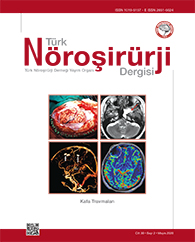Türk Nöroşirürji Dergisi
2020 , Vol 30 , Num 2
Head Injury and Epilepsy
1İstanbul Üniversitesi, İstanbul Tıp Fakültesi, Beyin ve Sinir Cerrahisi Anabilim Dalı, İstanbul, Türkiye
Post-traumatic epilepsy (PTE) is defined as recurrent spontaneous seizures occurring after traumatic brain injury. Post-traumatic
seizures are classified as early and late seizures. Early seizures are thought to occur after acute inflammatory response to the injury
while late seizures are thought to originate from biochemical reactions generated by iron disposition in brain tissue. Low admission
Glasgow coma score, early seizures, intracerebral hematoma, contusions, depressed skull fracture, dural penetration with metal
or bone fragments, midline shift greater than 5 mm, and operated acute subdural hematoma are the risk factors for PTE. Patients
with penetrating head injuries have the greatest risk for PTE. The purpose of treatment in early seizures is to prevent secondary
brain injury. Phenytoin and levetiracetam are the most commonly used antiepileptics in treatment. Non-convulsive seizures may
also occur frequently. Prophylaxis is recommended in the early post-traumatic period for high-risk cases; however, early prophylaxis
has been demonstrated to be ineffective for preventing PTE. In PTE patients with drug-resistant epilepsy, surgical treatments may
be considered.
Anahtar Kelimeler :
Epilepsy, Post-traumatic epilepsy, Head injury, Traumatic brain injury

